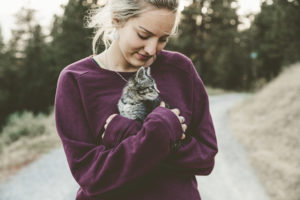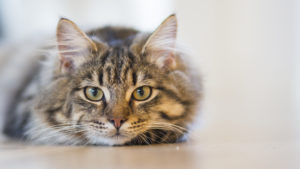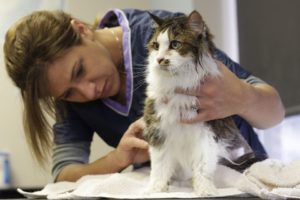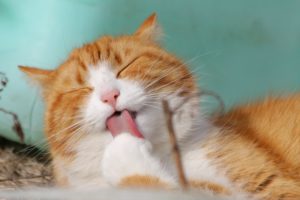Happy Cat = Happy Home
In this article we’ll look at 5 principles to ensure you benefit from a happy home and a happy cat.
#1 AFFECTION & ENGAGEMENT
 Whilst cats are known for being ‘fiercely independent’ they have a strong emotional need for certainty and stability. Cats don’t respond well to sudden change and value routine. Even though they might go off on the prowl they need to know they have a warm, safe, and comfortable home to come back to; part of this sense of home is having a reliable source of comfort and tactile affection they can count on.
Whilst cats are known for being ‘fiercely independent’ they have a strong emotional need for certainty and stability. Cats don’t respond well to sudden change and value routine. Even though they might go off on the prowl they need to know they have a warm, safe, and comfortable home to come back to; part of this sense of home is having a reliable source of comfort and tactile affection they can count on.
The benefits of petting your cat extend to improvements in your own wellbeing. Engaging in this tactile interaction has been shown to reduce blood pressure, lower stress, improve depression and elevate mood in both pet and owner.
You may wish to visit WebMD to find out more about the health benefits of petting animals.
# 2 LITTER TRAINING
 Cats tend to leave one of two surprises – neither of which are great treats. You’re either greeted in the morning with a dead mouse or, after work, your cat has kindle hidden a stinky little treatement somewhere in the house for you to discover.
Cats tend to leave one of two surprises – neither of which are great treats. You’re either greeted in the morning with a dead mouse or, after work, your cat has kindle hidden a stinky little treatement somewhere in the house for you to discover.
Cats are into cleanliness, but they tend to like to do things on their terms – so the best way to condition a cat to go with what you want is to align your preferred choice with theirs; meaning you want to condition your cat to prefer the litterbox to any other environment in your home.
You’ll want to make sure the litter box is kept clean by scooping out the litter each day and changing the litter at least once per week. Place the box in a quiet area of your home free from noise and distractions. Don’t use heavily scented litters that might be pleasant for you but could put your cat off using the litter tray; and try to avoid switching brands (as cats get spooked by sudden change).
EXERCISE
 You don’t tend to find many people taking their cat for a walk, and whilst this is technically possible, a much more realistic and less distressing option is to encourage your cat to chase after an interactive toy. Laser pointers in particular are a great tool. If you’re looking for exercise inspiration for your cat, then head over to: https://www.everydayhealth.com/pet-health/ten-cat-exercises.aspx
You don’t tend to find many people taking their cat for a walk, and whilst this is technically possible, a much more realistic and less distressing option is to encourage your cat to chase after an interactive toy. Laser pointers in particular are a great tool. If you’re looking for exercise inspiration for your cat, then head over to: https://www.everydayhealth.com/pet-health/ten-cat-exercises.aspx
# 3 DIET AND NUTRITION
 There’s a wide array of cat food options and many brands to pick from. The most important advice here is to look beyond the marketing fireworks and focus on the basic ingredient list; as this way you can determine the nutritional value of the product.
There’s a wide array of cat food options and many brands to pick from. The most important advice here is to look beyond the marketing fireworks and focus on the basic ingredient list; as this way you can determine the nutritional value of the product.
Cats can be connoisseurs when it comes to their food. If your cat has a more refined palette you might want to dip your toe into the trend of gourmet pet treats. Tastebuds aside, cats have specific nutritional requirements as they are “obligate carnivores” meaning they need animal proteins to stay healthy. You might want to head over to http://veratreats.com/ to check out their gourmet range of real meat pet treats.
Equally important to food is your cats need for water. Some cats are thirstier than others but ensuring an adequate and reliable supply of clean drinking water is absolutely essential to your cats health.
# 4 FLEA TREATMENT
 The most obvious sign your cat has fleas is that they are itching a lot. Then, there are the telltale signs on your own body in the form of little red bumps (often on your wrists or ankles). Treating fleas can be quite a challenge. When you comb through your cats fur, you might notice little black dots – these aren’t the fleas themselves, this is flea dirt (aka flea faeces).
The most obvious sign your cat has fleas is that they are itching a lot. Then, there are the telltale signs on your own body in the form of little red bumps (often on your wrists or ankles). Treating fleas can be quite a challenge. When you comb through your cats fur, you might notice little black dots – these aren’t the fleas themselves, this is flea dirt (aka flea faeces).
If you find ‘flea dirt’ then you need to do two things. (1) Treat the cat, and (2) Treat your home. It’s important to note that around 95% of fleas and flea eggs are likely to now be in your home rather than on your cat.
It is wise to consult your vet on which flea treatment is most effective for your cat, as it is somewhat dependent on medical history. Whilst flea treatment is highly effective in killing the fleas and eggs on your cat, the challenge is that if your cat is then in an environment where the fleas are still at large then re-infestation will occur.
To rid your home of fleas, you will probably need to repeat the elimination process a couple of times, to ensure any dormant eggs that didn’t get treated the first time around have since hatched and died. Here is a good resource on the steps to take to rid your home from fleas.
Fleas can take over your home. If you’ve grown accustomed to itching, whilst watching your favourite show at night – you need to turn to your greatest allies in this fight against the fleas; your vacuum cleaner and washing machine.
Anything that can be hot washed should be washed at a minimum temperature of 60 degrees. Anything too delicate to wash (e.g. cushions) can be put in the freezer to kill any fleas and eggs.
However, in reality, prevention is much better than cure. Your vet can advise you on the most suitable prophylactic measures whilst this article provides some great advice on how to deal with fleas.
#5 GROOMING
 Your cats tongue is covered with backward pointing spines designed to groom coats and remove loose hair, however, it doesn’t hurt to offer a helping hand. In addition to the physiological benefit of grooming (e.g. prevents the formation of hairballs and stimulates the skins production of natural oils) there are clear psychological benefits to both you and your cat. The grooming process can be very therapeutic and is a brilliant way to reinforce the bond between you and your cat. International Cat Care provides some great advice on how to groom your cat.
Your cats tongue is covered with backward pointing spines designed to groom coats and remove loose hair, however, it doesn’t hurt to offer a helping hand. In addition to the physiological benefit of grooming (e.g. prevents the formation of hairballs and stimulates the skins production of natural oils) there are clear psychological benefits to both you and your cat. The grooming process can be very therapeutic and is a brilliant way to reinforce the bond between you and your cat. International Cat Care provides some great advice on how to groom your cat.















Your tips are looking useful. I am going to try with my cat, Thanks for sharing.